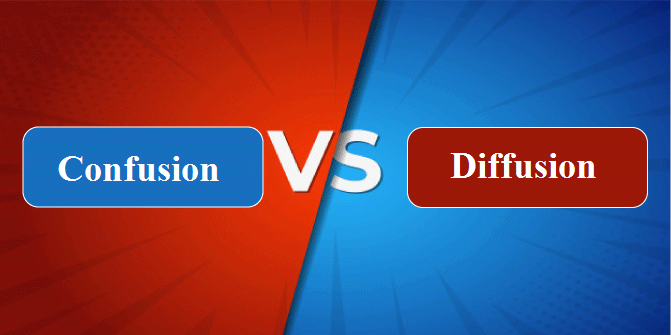Difference between Confusion and Diffusion in CryptographyConfusion and diffusion are both properties for creating a secure cipher. Confusion and diffusion are both used to prevent the encryption key from its deduction or to prevent the original message from being transmitted. Confusion is utilized to create clueless ciphertext, whereas diffusion is utilized to increase the redundancy of the plaintext over most of the ciphertext to make it obscure. The stream cipher relies solely on confusion. On the other hand, diffusion is also utilized both stream and block ciphers. In this article, you will learn about the difference between Confusion and Diffusion. But before discussing the differences, you must know about Confusion and Diffusion. What is Confusion?Confusion is a cryptographic mechanism that is utilized to increase the obscurity of the ciphertext. In simple words, the technique assures that the ciphertext has no information about the plaintext. The confusion technique keeps the relationship between the encrypted text's statistics and the encryption key's value as complex as possible. Even if the attacker gains some control over the ciphertext's statistics, he will be unable to determine the secret because the method by which the key was utilized to generate the ciphertext is so complex. Confusion may be created by employing substitution and a complicated scrambling algorithm that is dependent on the key and the input (plaintext). What is Diffusion?Diffusion may be used to define the property that the repetition in the plaintext statistics "dissipates" in the ciphertext statistics. In diffusion, the output bits must be challengingly dependent on the input bits so that if the plaintext is modified by only one bit, the ciphertext must change in an unanticipated or unreliable way. The statistical technique of the plaintext is utilized up into high-range data of the ciphertext during diffusion. It is achieved by influencing the value of some ciphertext digits with each plaintext digit, and it is frequently similar to having certain plaintext digits impact each ciphertext digit. Key Differences between the Confusion and Diffusion
There are various key differences between Confusion and Diffusion. Some main differences between Confusion and Diffusion are as follows:
Head-to-head comparison between Confusion and DiffusionHere, you will learn the head-to-head comparisons between Confusion and Diffusion. The main differences between Confusion and Diffusion are as follows:
ConclusionConfusion and diffusion are both cryptographic approaches. In confusion, the relationship between the ciphertext's statistics and the encryption key's value is as difficult as possible. On the other hand, diffusion attempts to disguise the statistical nature of the plaintext by spreading the influence of each individual plaintext digit over a large number of ciphertext digits.
Next TopicDifference between
|
 For Videos Join Our Youtube Channel: Join Now
For Videos Join Our Youtube Channel: Join Now
Feedback
- Send your Feedback to [email protected]
Help Others, Please Share










